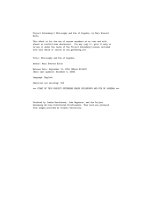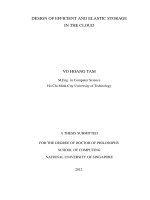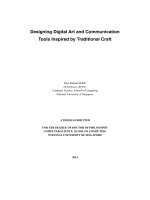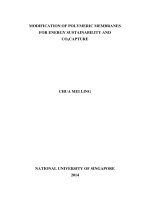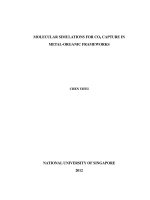Efficient and reversible CO2 capture by amine functionalized-silica gel confined task-specific ionic liquid system
Bạn đang xem bản rút gọn của tài liệu. Xem và tải ngay bản đầy đủ của tài liệu tại đây (1.57 MB, 7 trang )
Journal of Advanced Research (2015) 6, 571–577
Cairo University
Journal of Advanced Research
ORIGINAL ARTICLE
Efficient and reversible CO2 capture by amine
functionalized-silica gel confined task-specific ionic
liquid system
Javad Aboudi, Majid Vafaeezadeh
*
Department of Chemistry and Chemical Engineering, Malek Ashtar University of Technology, Shahid Babaei Highway, Lavizan,
Tehran, Iran
A R T I C L E
I N F O
Article history:
Received 16 December 2013
Received in revised form 2 February
2014
Accepted 4 February 2014
Available online 8 February 2014
Keywords:
CO2 absorption
Task-specific ionic liquid
Mesoporous material
Carbon dioxide fixation
A B S T R A C T
Simple, efficient and practical CO2 capture method is reported using task-specific ionic liquid
(IL) supported onto the amine-functionalized silica gel. The results have been shown that both
the capacity and rate of the CO2 absorption notably increase in the supported IL/molecular
sieve 4 A˚ system in comparison of homogeneous IL. Additionally, it has shown that the prepared material is capable for reversible carbon dioxide absorption for at least 10 cycles without
significant loss of efficiency. The presence of the amine-based IL and the surface bonded amine
groups increase the capacity of CO2 absorption even in a CO2/CH4 gas mixture through the formation of ammonium carbamate onto the surface of mesoporous material.
ª 2014 Production and hosting by Elsevier B.V. on behalf of Cairo University.
Introduction
Carbon dioxide (CO2) is a harmful greenhouse gas with
50–200 years life-time in the atmosphere and made up 84%
of U.S. greenhouse gas emission from human activities [1].
Moreover, removal of carbon dioxide from the acidic natural
* Corresponding authors. Tel.: +98 21 22945141 6; fax: +98 21
22935341.
E-mail address: (M. Vafaeezadeh).
Peer review under responsibility of Cairo University.
Production and hosting by Elsevier
gas (a gas which contains significant amount of acidic carbon
dioxide) is a vital step in the gas sweetening operations [2].
In the past decades, various methods have been proposed for
CO2 capture [3] mainly using ionic liquids (ILs) [4–7]. The term
"task-specific" IL refers to non-solvent applications of the IL
such as catalysis, synthesis and gas absorption [8,9]. Amine
based ILs first reported by Bates et al. [10] and extended with
others [11,12] are desirable liquids for carbon dioxide absorption. Despite simple synthetic method and using commercially
available starting material, the major drawback of this compound is attributed to half-molar CO2 uptake per one mol of
IL. Moreover, the homogeneous ILs mainly suffer from gas diffusion limitation specially by increasing the viscosity of the
CO2-captured ILs. Recently Wu and co-workers showed that
N-(3-aminopropyl) aminoethyl tributylphosphonium amino
2090-1232 ª 2014 Production and hosting by Elsevier B.V. on behalf of Cairo University.
/>
572
J. Aboudi and M. Vafaeezadeh
acid based ILs which were supported into the mesoporous silica
material had excellent efficiency toward reversible CO2 capture
[13]. Organoamines-grafted on nano-size silica [14] and electrochemical reduction of carbon dioxide are also among the successful and suitable methods reported for CO2 utilizing [15].
Here, an amine-functionalized mesoporous material which
confined by amine based IL is reported for CO2 absorption/
desorption. The aim of modifying the surface with amine precursor is to provide surface amine groups to form ammonium
carbamate species with IL after CO2 uptake. To increase the
gas rate and the absorption capacity, molecular sieve 4 A˚
(which is traditionally used for absorption of carbon dioxide)
was added to the system.
Experimental
Preparation of the IL
The IL was prepared according to the known literature procedure [10] with some modifications (Scheme 1a). To a round
bottom flask equipped with a condenser, 1-methylimidazol
and 2-bromoethylamine hydrobromide were added and the
mixture was refluxed in ethanol to form IL 1. After 48 h, the
solvent was removed by applying vacuum and the residue
was dissolved in minimum amounts of water. The pH of the
solution was increased to nearly 8 by adding solid KOH. Then
the mixture was slowly filtrated from solid KBr by-product followed by evaporation of the solvent. Then, the resulted IL 2
was dissolved in minimum volume of ethanol to precipitate
residual KBr. Subsequent anion exchange of the resulted IL
was performed with NaBF4 in ethanol at room temperature
Scheme 1
for 24 h (Scheme 1a). IL 3: 1H NMR 500 MHz D2O: 3.19
(2H), 3.38 (2H), 3.73 (3H), 4.42 (2H), 7.31 (1H), 7.40 (1H),
8.69 (1H); 19F NMR 500 MHz D2O: À148.9. FT-IR (liquid
film): 3486, 3145, 3081, 2859, 2066, 1635, 1564, 1464, 1378,
1166 and 1021.
Preparation of the amine-functionalized mesoporous material
Silica gel Davisilä grade 635 (average pore diameter 60 A˚,
pore volume 0.75 cm3 gÀ1, surface area 480 m2 gÀ1) was activated by refluxing in 6 M hydrochloric acid (HCl). After
24 h, the silica gel was washed thoroughly with deionized water
to adjust the pH of the solution to 6–7 and dried at 90 °C before undergoing surface modifications. For a sample reaction,
80 g of the activated silica gel was mixed with 70 mmol
($18 mL) of 2-[2-(3-Trimethoxysilylpropylamino)ethylamino]
ethylamine in dry toluene. The mixture was heated at 110 °C
for 24 h. Then, the solid materials were filtered off and washed
with hot toluene for 12 h in a continuous extraction apparatus
(Soxhlet) and then dried in an oven at 90 °C to give 92 g of surface-bonded amine groups, material A (Scheme 1b).
Preparation of the silica supported IL (material B)
The IL was supported on the surface of the mesoporous material applying physisorption method [16,17]. Typically, an ethanol solution of the 36 mL ($46.5 g) of IL 3 was added to a
mixture of 84.75 g material A and 400 mL ethanol over 1 h.
The reaction mixture was stirred for 2 h and then the solvent
was removed under reduced pressure to afford material B
(Scheme 1b) as a yellow powder ($55 wt.% IL 3/material A).
Synthesis route to IL 3 (a), schematic illustration of preparing material B by physisorb confinement method (b).
Reversible CO2 capture using supported task-specific ionic liquid system
573
Fig. 1 FT-IR spectroscopy of the pure silica, material A and material B before and after CO2 uptake (a) N2 adsorption/desorption
isotherm of the material B (b).
Material B was dried in oven at 80 °C before gas absorption
experiments.
CO2 uptake experiment of material B/molecular sieve 4 A˚
CO2 absorption was carried out in a tube which was filled
with a mixture of the material B and molecular sieve 4 A˚.
In this regard, the experiment setup was prepared by mixing
40 g of molecular sieve 4 A˚ and 20 g of material B. Molecular
sieve and material B were dried before CO2 treatment. Top
and bottom sides of the apparatus are fixed by cotton. Nitrogen was used as an inert gas before carbon dioxide treatment.
The purity of CO2 and N2 gases was 99.95%. The absorption
was carried out at 25 °C for 2 h and at atmosphere pressure
with a gas flow rate of 100 ± 5 mL/min. After the absorption
experiment, the material was placed at room temperature and
pressure to remove physisorbed CO2 until reaching to a
constant weight. Desorption experiments was performed in
a rotary evaporator at 45 °C by applying vacuum (100 mbar)
and at 85 °C at atmosphere pressure. The amounts of CO2
were determined with an analytical scale with accuracy of
±0.001 g.
at 25 °C for 3 h and at atmosphere pressure with a gas flow
rate of 100 ± 5 mL/min. Desorption experiment was performed in rotary evaporator at 45 °C by applying vacuum
(100 mbar). During the CO2 uptake experiment, the mixture
of IL 3 was stirred at 600 rpm to provide a homogeneous
gas/liquid connection. The changes in the weight of the IL
was recorded each 30 min with an analytical scale with accuracy of ±0.001 g.
CO2 uptake experiment of material B/molecular sieve 4 A˚ from
CO2/CH4 mixture
The gas preparation system for the CO2 capture experiment
from the CO2/CH4 mixture was designed according to the
known literature method [18]. In this experiment nitrogen
was used as an inert gas before CO2 treatment. CO2 and
CH4 were passed from two different valves with the pressure
100 mL/min and then mixed to one line. The absorption experiment was performed according to the method described for
material B/molecular sieve 4 A˚ except the uptake time which
was performed for 160 min.
Results and discussion
CO2 uptake experiment of IL 3
In a typical experiment, 7 g of IL 3 was added to a sample
tube. The absorption and desorption experiments were performed according to the identical condition performed for
material B (see above). Nitrogen was used as an inert gas before CO2 treatment experiment. Absorption was carried out
The IL 3 was synthesized by the reaction of 1-methylimidazol
and 2-bromoethylamine hydrobromide following anion exchange with NaBF4 at room temperature (Scheme 1).
Material A was easily synthesized by grafting the commercially available amine precursor on the silica surface in the
reflux of the toluene. The loading of amine groups was
574
J. Aboudi and M. Vafaeezadeh
Fig. 2
CO2 absorption experiment setup and kinetic results for IL 3 (a) and material B/molecular sieve system (b).
Fig. 3 Results of absorption and desorption experiment (a) recycling results for CO2 absorption experiment of material B/molecular
sieve system (b).
calculated from the increasing the weight of the final material
A to be about 0.5 mmol/g of silica. Material B was prepared by
impregnation of IL 3 in the form of supported liquid phase (SLP)
[16] onto the as-synthesized material A (Scheme 1b). In this regard, ethanol solution of the IL 3 was gradually added to a suspension containing fine particles of material A and ethanol.
Comparative FT-IR spectra of pure silica, material A and
material B are shown in Fig. 1a. In material A, the characteristics bands at 2852 and 2926 cmÀ1 are attributed to CAH and
NAH stretching frequencies of the surface alkyl amine functionalities. The corresponding bands at 3148, 3180, 2961,
2933 and 2865 cmÀ1 in material B belong to aromatic and aliphatic CAH and aliphatic NAH stretching frequencies of the
supported IL 3 in material B. It is worth mentioning that the
bands observed near the 1464 and 1748 cmÀ1 in both of material A and B are attributed to the NAH bending frequencies
and C‚N aromatic frequencies of imidazolium ring of the
supported IL 3.
Reversible CO2 capture using supported task-specific ionic liquid system
Fig. 4
575
Proposed mechanism of CO2 capture with material B.
Fig. 5 CO2 absorption experiment for material B/molecular
sieve system, CO2/CH4 mixture, pure molecular sieve and
absorption at 110 °C.
N2 adsorption/desorption isotherm of the material B is
shown in the Fig. 1b. BET (Brunauer–Emmett–Teller) surface
area of the catalyst was decreased from the initial 480 m2 gÀ1
to 127 m2 gÀ1. Moreover, the pore volume of the material B
was reduced from the initial 0.75 cm3 gÀ1 to 0.31 cm3 gÀ1.
The mean pore diameter of the catalyst calculated to be
6.4 nm derived from the BJH (Barrett–Joyner–Halenda) average pore diameter analysis. The decrease in surface area and
the pore volumes in the N2 adsorption–desorption analysis
of the material B were clearly prove that the IL 3 was supported onto the channels of the mesoporous material A.
Before the carbon dioxide uptake experiment, material B
and molecular sieve was dried in an oven to remove any residual water and ethanol which was used during the material
preparations. The color of the resulted material is pale yellow
and cannot be easily differentiated by sight.
To enhance the absorption rate and capacity of the system,
material B (20 g) was mixed with molecular sieve 4 A˚ (40 g).
This allows increasing the experiment gas flow rate to
100 mL/min and decreasing the experiment time. The other
end of the absorbent apparatus was conducted to a ventilation
system to pass out carbon dioxide out of the lap space. It is
worth mentioning that the molecular sieve 4 A˚ is a commercially available material which can specifically absorb small
molecules such as CO2 and NH3.
The amount of carbon dioxide uptake was determined
according to the reported literature method [16] using analytical balance with accuracy of ±0.001 g. To provide a kinetic
comparison, CO2 absorption was also performed for pure
IL. In this regard, 7 g of IL 3 (equal to its amount which
was used for preparation of 20 g material B was added to a
sample tube and the liquid was treated with the flow of carbon
dioxide. The experiment setup and kinetic results of IL 3 and
material B/molecular sieve system are shown in Fig. 2.
The result suggested that the amount of CO2 absorption
reaches near to the theoretical value after 3 h. The viscosity
of the IL 3 in homogeneous CO2 capture experiment was increased during the CO2 treatment which this factor usually
causes some technical problem. However, in the case of material B/molecular sieve system, only after 1 h the system absorb
more than 94% of its final absorption capacity.
576
The weight changes in material B/molecular sieve was recorded every 20 min. In this regard for each step, the gas flow
is terminated and the apparatus was placed at room temperature to remove physisorbed carbon dioxide. When the mass of
the material reached to a constant value, it was recorded. The
results show that the presented system absorbs 4.25 g carbon
dioxide after 2 h treatment. The results of absorption–desorption experiments and recycling of the material B/molecular
sieve for CO2 uptake are shown in Fig. 3.
For desorption experiment, the apparatus constituent was
transferred to a round bottom flask of a rotary evaporator system by applying vacuum (100 mbar) and 45 °C for 30 min.
Every 5 min the sample was weighted and the data were recorded. The results suggested that the presented CO2 absorption system can easily release the carbon dioxide under mild
temperature condition after 30 min. Desorption experiment
was also performed at atmospheric pressure to explore the role
of the applied vacuum. It is found that the lowest temperature
to perform efficient desorption for 30 min is 85 °C. This observation clearly indicates that applying the vacuum is necessary
to perform efficient desorption at mild thermal condition. To
investigate the recyclability of the material, the recovered
material B/molecular sieve 4 A˚ was subjected to another carbon dioxide absorption experiment. It was shown that the
absorbent can be reused for at least 10 cycles without noticeable loss of efficiency (Fig. 3b).
Worthy to note that the both of the surface-bonded amine
groups and IL 3 are capable to interact with carbon dioxide.
This fact proposed a synergetic effect between IL 3 and the
surface grafted amine which can increase the CO2 capture
capacity. In this regard, it is proposed that the absorption
mechanism comprises formation the ammonium carbamate
onto the surface of the mesoporous material after CO2 uptake
(Fig. 4).
FT-IR analysis of material B before and after CO2 absorption is shown in Fig. 1a. A new and characteristic band which
was observed at 1641 cmÀ1 is attributed to C‚O stretching
frequency of carbamate moiety of the surface bonded ammonium carbamate. This observation proves the hypothesis of
forming ammonium carbamate in the material B.
Separation of CO2 from a mixture of gases such as CO2/
CH4 is an important issue since CH4 is a valuable source of energy. In the sour gas, CO2 participate as an impurity which directly decrease the heat capacity of methane (CH4). Our
attempts for separation CO2 from a mixture of CO2/CH4
showed that the applied system for carbon dioxide absorption
can also capture CO2 from the CO2/CH4 mixture with slightly
longer time (Fig. 5). To study the effect of pure molecular
sieve, 40 g of this absorbent was treated for carbon dioxide
capture. The results show that the rate and the capacity of
molecular sieve 4 A˚ are smaller than those of material B/
molecular sieve 4 A˚ system. A gap of CO2 uptake capacity
($1.2 g) which exists between molecular sieve and material
B/molecular sieve system (see Fig. 5) is attributed to the
amount of CO2 absorbing of 20 g of material B. Our attempts
to perform CO2 capture at elevated temperature did not lead
to a desirable result (Fig. 5). A plausible explanation to interpret significantly lower absorption may be due the fact that at
high
temperature
absorption–desorption
phenomena
simultaneously occur and the material is not capable to retain
the captured carbon dioxide.
J. Aboudi and M. Vafaeezadeh
Conclusions
In summary, a new amine based IL confined onto the mesoporous material modified with amine group was designed for
reversible CO2 absorption. The results showed that combination of molecular sieve with material B, notably increase the
rate and the amounts of CO2 absorption even for CH4/CO2
gas mixture. All the material was synthesized with commercially available starting material. The measurements showed
that the rate and kinetic of CO2 absorption of the supported
IL system were much higher than those of the pure IL 3. Moreover, no special precaution is need for this system in comparison with homogeneous IL. It is believed that the presented
method is a good candidate to replace the traditional absorbent methods even for large-scale CO2 capture applications.
Conflict of interest
The authors have declared no conflict of interest.
Compliance with Ethics Requirements
This article does not contain any studies with human or animal
subjects.
References
[1] Overview of Greenhouse Gases. Carbon Dioxide Emissions,
United States Environmental Protection Agency.
[2] Bara JE, Carlisle TK, Gabriel CJ, Camper D, Finotello A, Gin
DL, et al. Guide to CO2 separations in imidazolium-based
room-temperature ionic liquids. Ind Eng Chem Res 2009;48:
2739–51.
[3] Spigarelli BP, Kawatra SK. Opportunities and challenges in
carbon dioxide capture. J CO2 Util 2013;1:69–87.
[4] Privalova E, Nurmi M, Maran˜o´n MS, Murzina EV, Ma¨kiArvela P, Era¨nen K, et al. CO2 removal with ‘switchable’ versus
‘classical’ ionic liquids. Sep Purif Technol 2012;97:42–50.
[5] Gurkan BE, de la Fuente JC, Mindrup EM, Ficke LE, Goodrich
BF, Price EA, et al. Equimolar CO2 absorption by anionfunctionalized ionic liquids. J Am Chem Soc 2010;132:2116–7.
[6] Wang C, Luo H, Li H, Zho X, Yu B, Dai S. Tuning the
physicochemical properties of diverse phenolic ionic liquids for
equimolar CO2 capture by the substituent on the anion. Chem
Eur J 2012;18:2153–60.
[7] Wang C, Luo H, Jiang D, Li H, Dai S. Carbon dioxide capture
by superbase-derived protic ionic liquids. Angew Chem Int Ed
2010;49:5978–81.
[8] Giernoth R. Task-specific ionic liquid. Angew Chem Int Ed
2010;49:2834–9.
[9] Vafaeezadeh M, Mahmoodi Hashemi M. Dual catalytic
function of the task-specific ionic liquid: Green oxidation of
cyclohexene to adipic acid using 30% H2O2. Chem Eng J
2013;221:254–7.
[10] Bates ED, Mayton RD, Ntai I, Davis Jr JH. CO2 capture by a
task-specific ionic liquid. J Am Chem Soc 2002;124:926–7.
[11] Camper D, Bara JE, Gin DL, Noble RD. Room-temperature
ionic liquid-amine solutions: tunable solvents for efficient and
reversible capture of CO2. Ind Eng Chem Res 2008;47:8496–8.
[12] Sharma P, Park SD, Park KT, Nam SC, Jeong SK, Yoon YI,
et al. Solubility of carbon dioxide in amine-functionalized ionic
liquids: role of the anions. Chem Eng J 2012;193–194:267–75.
Reversible CO2 capture using supported task-specific ionic liquid system
[13] Ren J, Wu L, Li B. Preparation and CO2 sorption/desorption of
N-(3-aminopropyl) aminoethyl tributylphosphonium amino
acid salt ionic liquids supported into porous silica particles.
Ind Eng Chem Res 2012;51:7901–9.
[14] Czaun M, Goeppert A, May RB, Peltier D, Zhang H, Prakash
GKS, et al. Organoamines-grafted on nano-sized silica for
carbon dioxide capture. J CO2 Util 2013;1:1–7.
[15] Ogura K. Electrochemical reduction of carbon dioxide to
ethylene: mechanistic approach. J CO2 Util 2013;1:43–9.
[16] Vafaeezadeh M, Mahmoodi Hashemi M, Shakourian-Fard M.
Design of silica supported task-specific ionic liquid catalyst
577
system for oxidation of cyclohexene to adipic acid with 30%
H2O2. Catal Commun 2012;26:54–7.
[17] Karimi B, Vafaeezadeh M. SBA-15-functionalized sulfonic acid
confined acidic ionic liquid: a powerful and water-tolerant
catalyst for solvent-free esterifications. Chem Commun 2012;48:
3327–9.
[18] Silva JAC, Cunha AF, Schumann K, Rodrigues AE. Binary
adsorption of CO2/CH4 in binderless beads of 13X zeolite.
Microporous Mesoporous Mater 2014;187:100–7.
